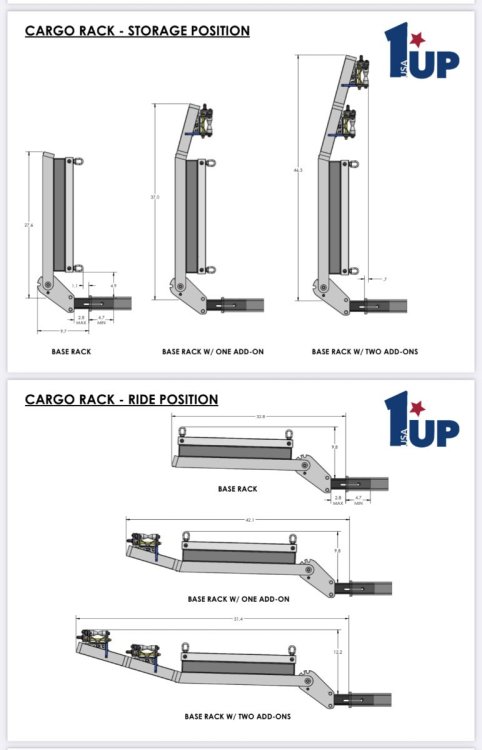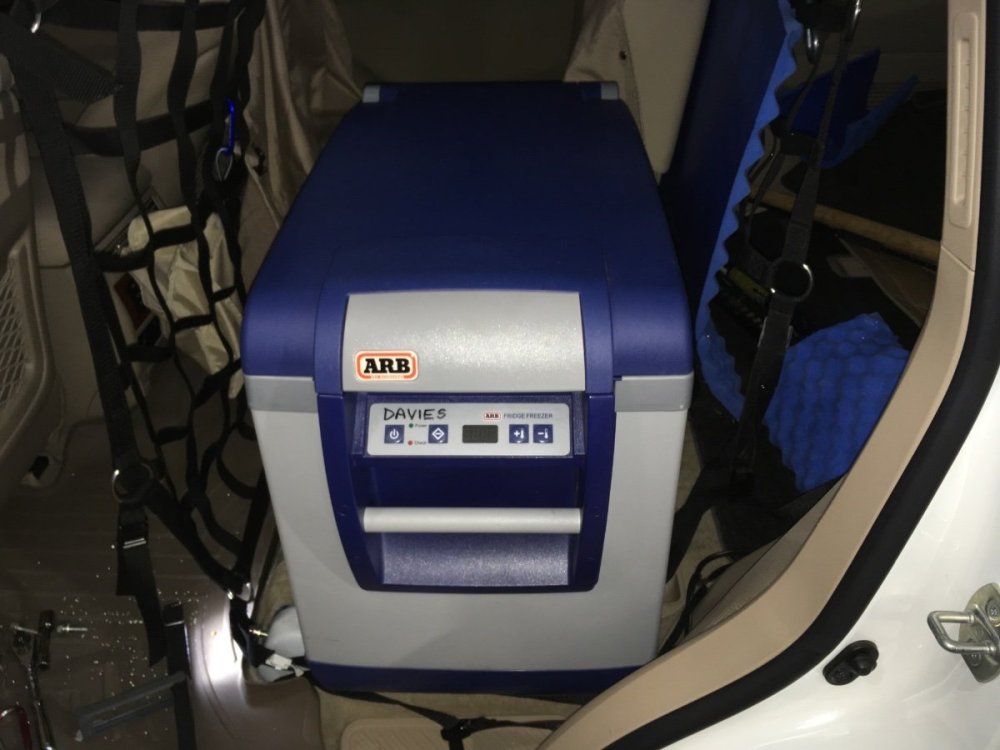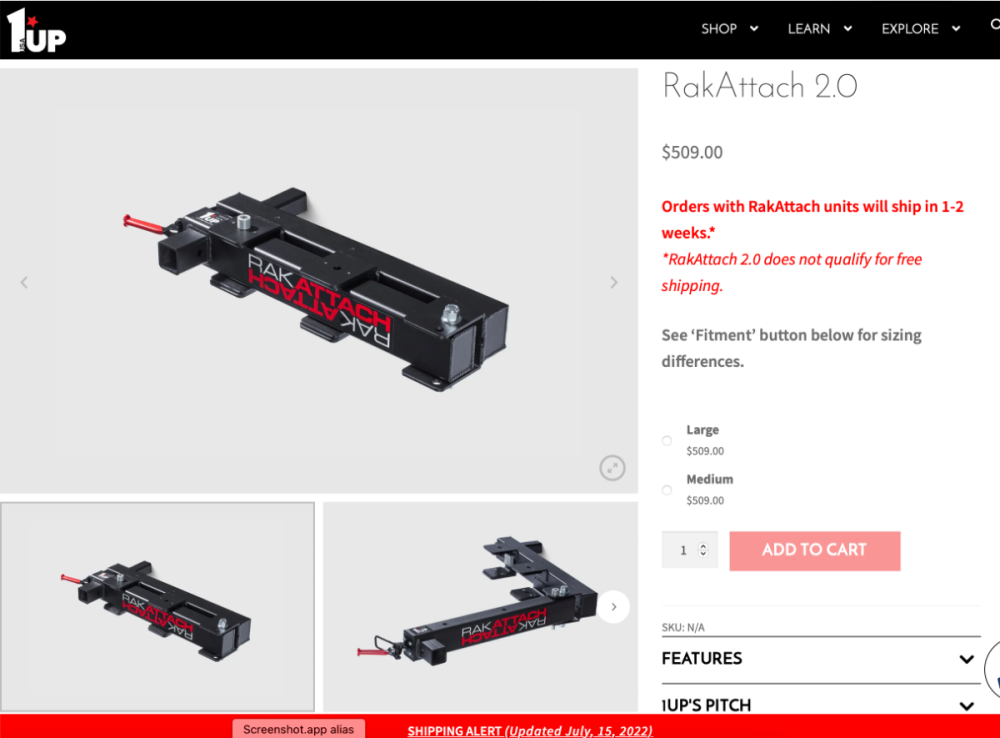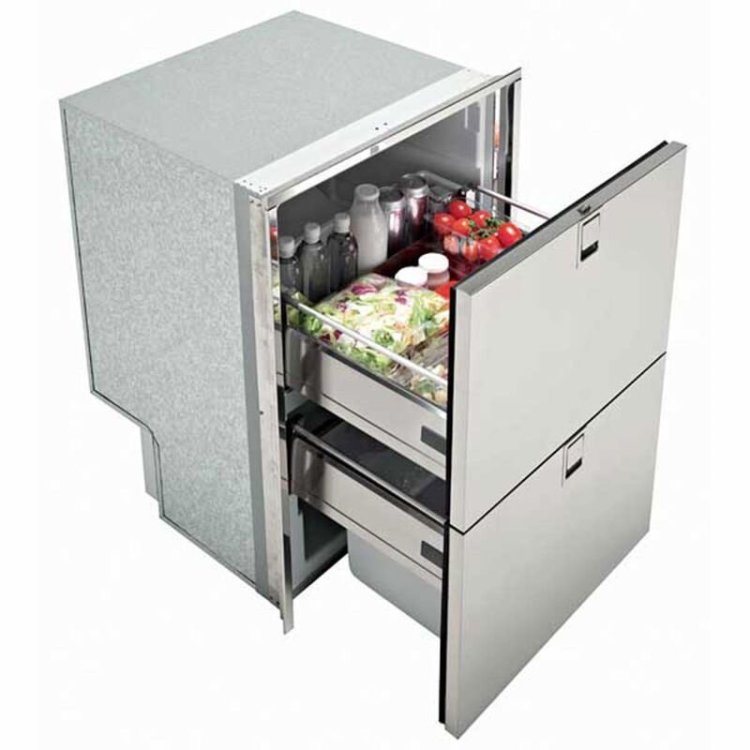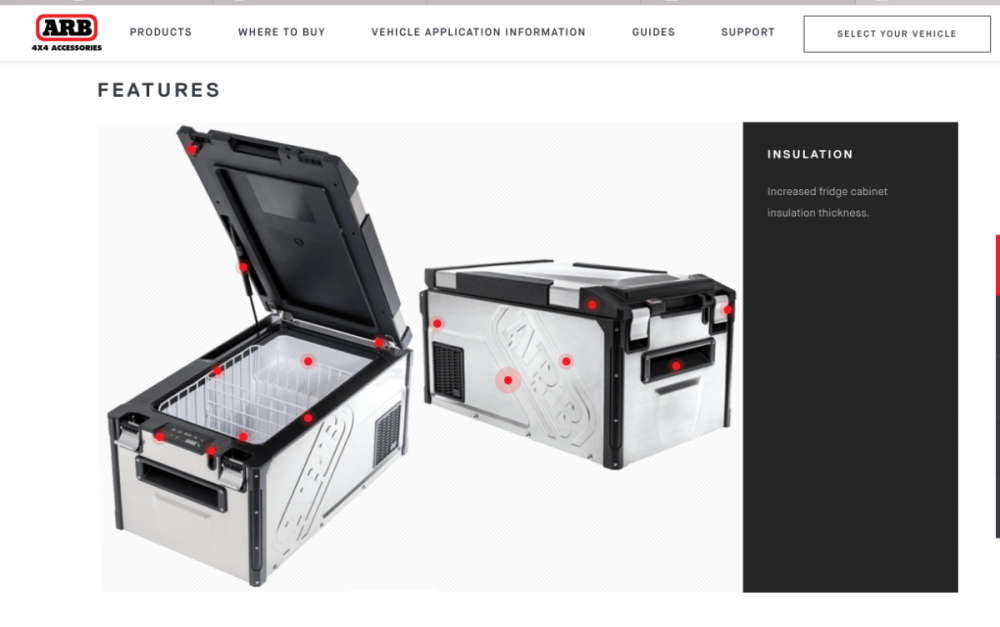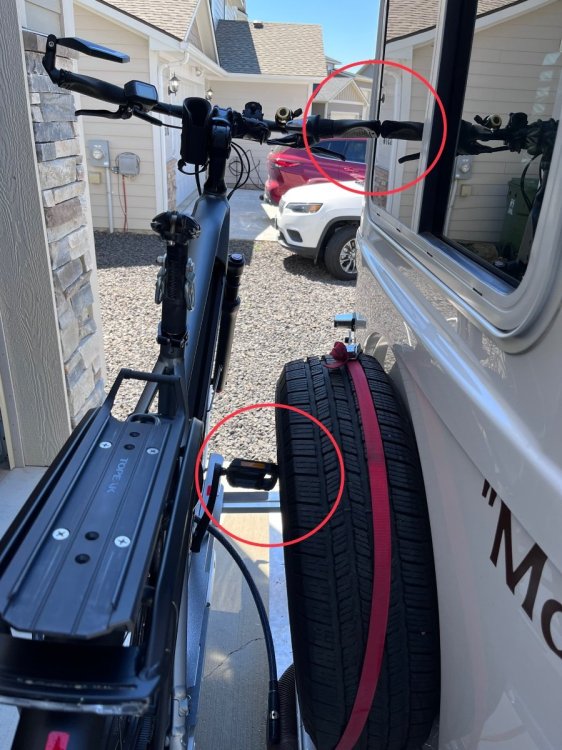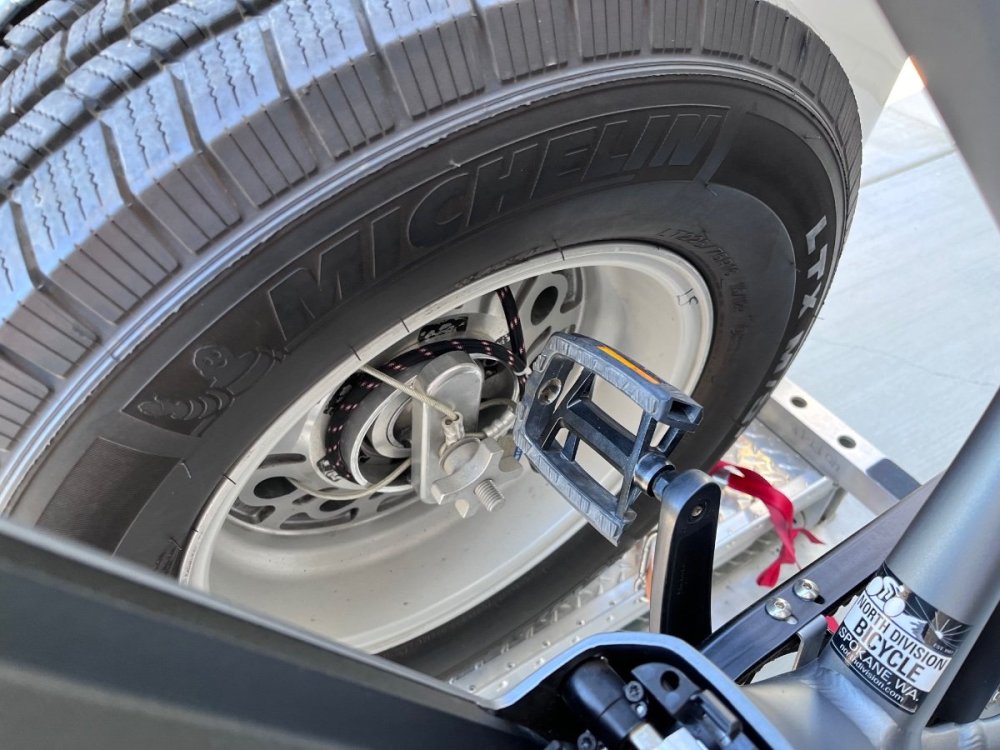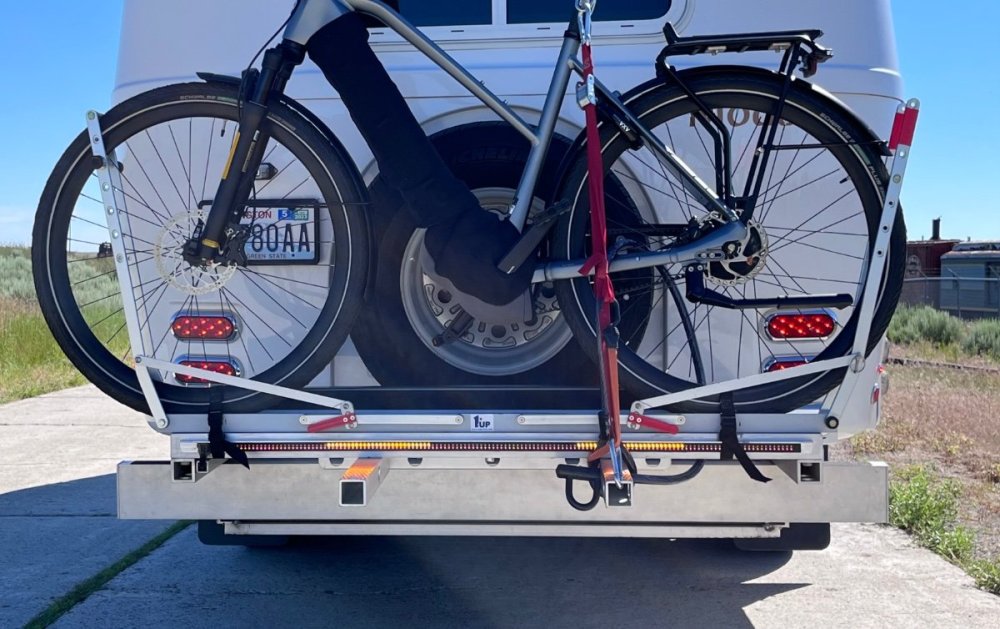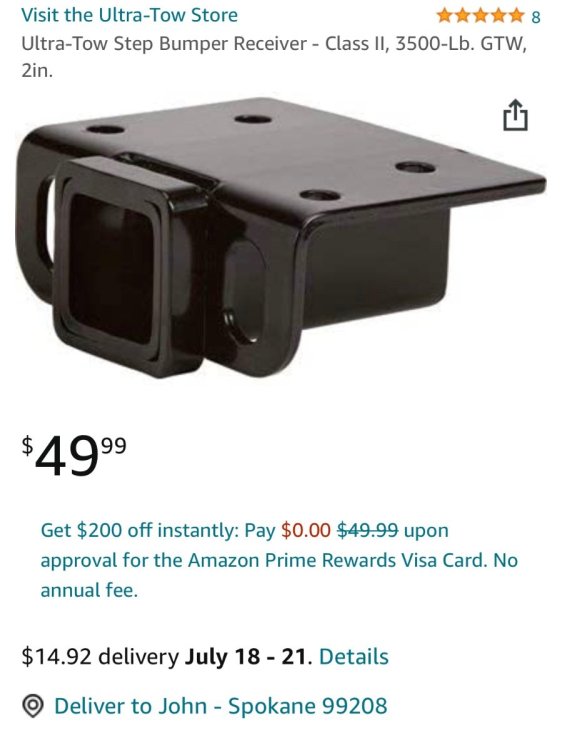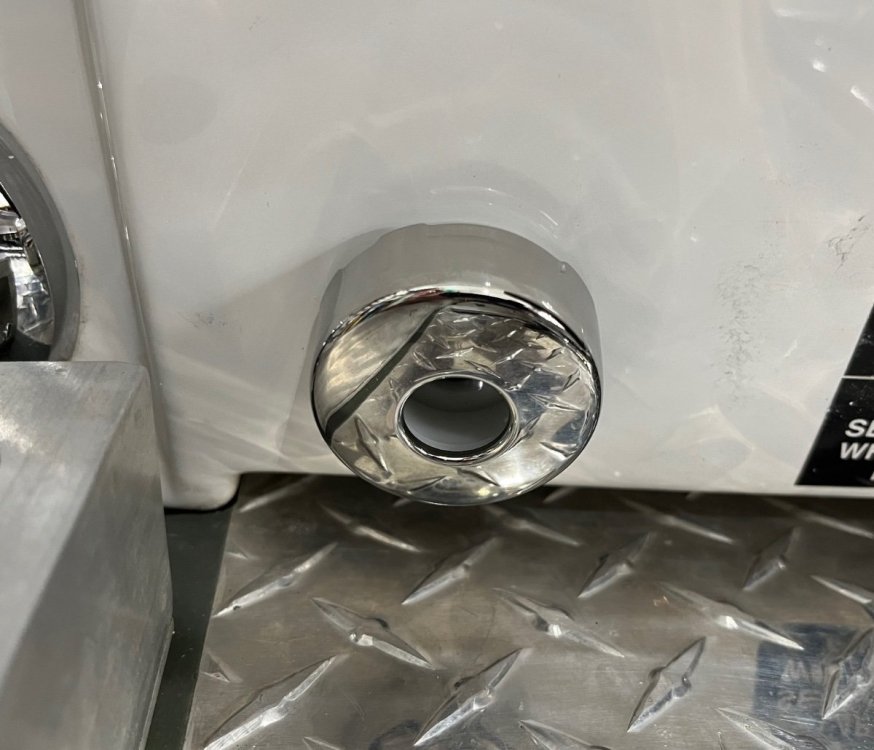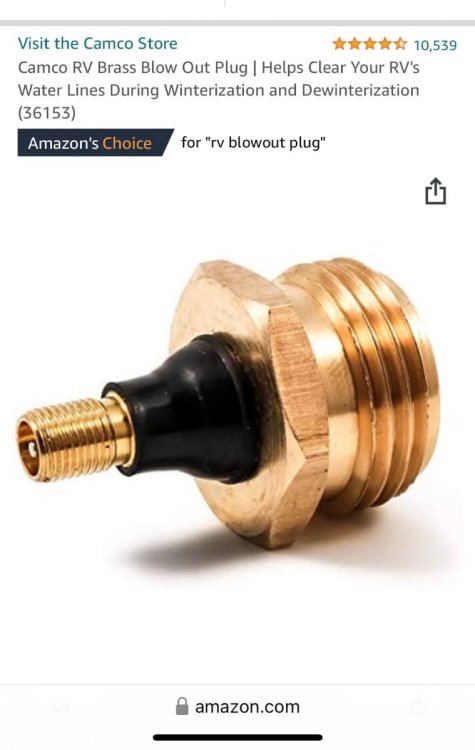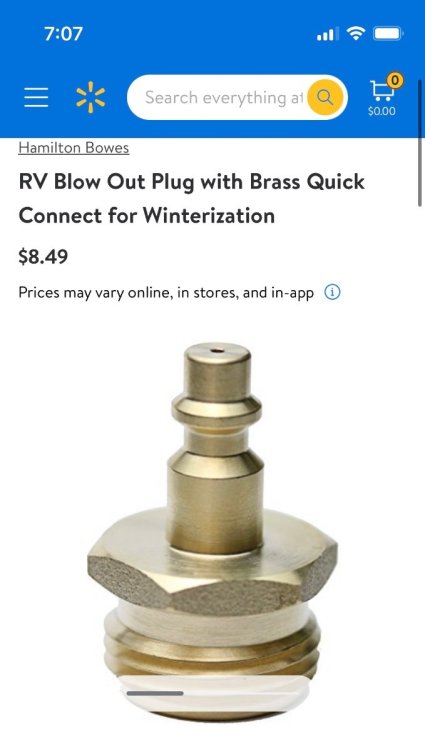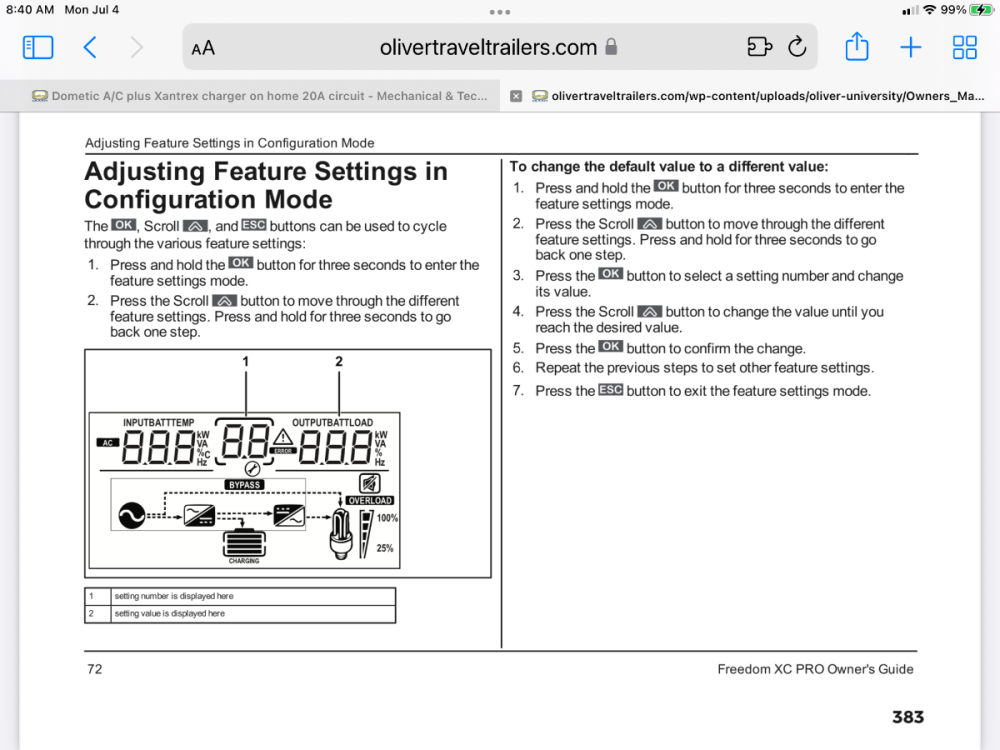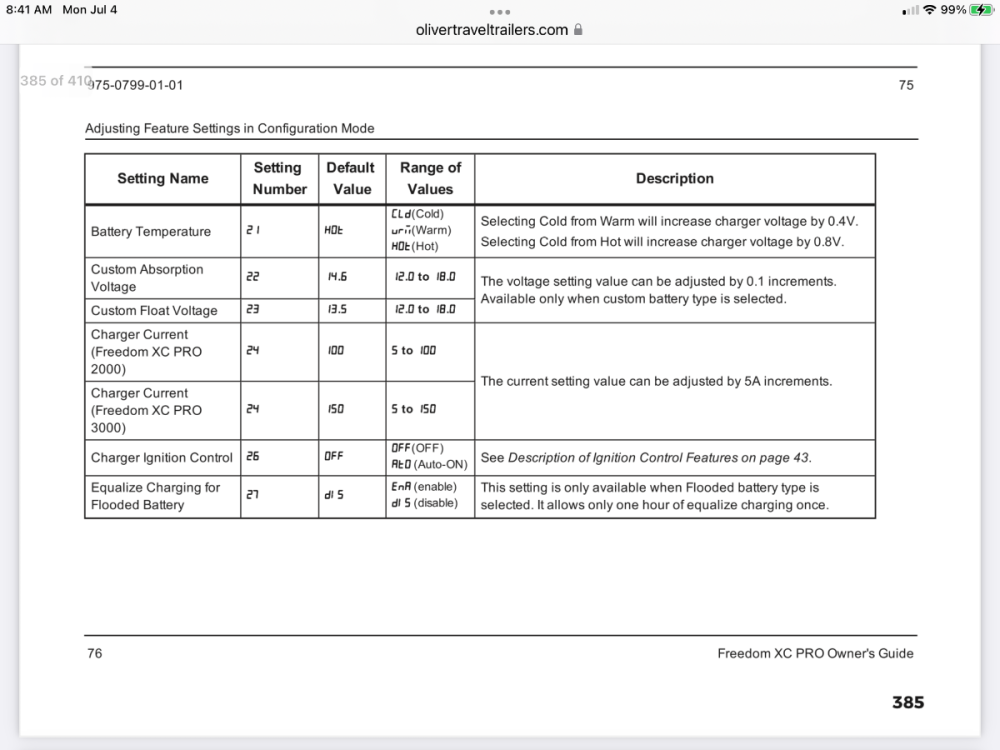-
Posts
5,759 -
Joined
-
Last visited
-
Days Won
243
Everything posted by John E Davies
-

Transporting portable waste tank
John E Davies replied to PapaBiker's topic in Mechanical & Technical Tips
I wouldn’t want to trust an adapter, there have been threads here about changing the small Ollie receiver to a steel 2” one. Once you do that the choices for a cargo rack are many, Just be sure to pick an RV rated one. I really like my 1-Up bike racks and would buy one of their folding trays in a heartbeat. What are the dimensions of your tank? Will it obscure the rear trailer lights? I would install this: Ultra-Tow Step Bumper Receiver - Class II, 3500-Lb. GTW, 2in. Then use one of these: https://www.1up-usa.com/product-category/cargo-carriers/ Alternatively have you thought about a front receiver for your truck? Carry the tank here, it would be out of the way as long as you always remember it is there😳 An extra benefit is you can use a front ball mount to maneuver your trailer, just not at the same time…. John Davies Spokane WA -
I don’t have direct knowledge, I ran across this document that might help. n/no co Fault Code – No cooling detected by the controls Board reset procedure. First step is to open up the outside compartment and look closely for some blockage, for example mud dauber nests. If you have never done so, blow out that area gently with compressed air, including the control board area. Watch your eyes! The gas jet in the burner section could be restricted, a crusty deposit gradually builds up around the hole, that is very common. I have a Dometic fridge, so I can’t be more specific. Good luck. Maybe consider buying a portable Danfoss compressor fridge/ cooler locally for backup in case it stays dead. At least that would not completely sabotage your vacation trip. You could always sell it when you get back, they are not cheap. Where do you live, please add that info to a Signature along with your hull number and model. If you were near me I would let you borrow my ARB one. John Davies Spokane Wa
-
That is one big advantage of a HD pickup, you can get rid off the Andersen and use one of those.... Just make sure the ball and mount are both rated for at least 7500 pounds and keep the front of the Ollie light (no big generator in a cargo tray). The weight of the bikes and their rack and the ball mount all count toward the tongue weight. What is the max TW rating for that Curt ball mount? 750? Two typical 60 pound ebikes and an ebike rated rack with swing out adapter could use up 200+ pounds of TW (with the batteries removed). For a loaded LE2 (with a typical TW of 650) that is going to be way too much. For example, this swing-out mount weighs 58 pounds by itself, an aluminum Super Duty Double rack weighs 47 pounds. Steel racks are quite a bit heavier. John Davies Spokane WA
-

Boondocking without enough battery capacity
John E Davies replied to NCeagle's topic in Mechanical & Technical Tips
Established primitive campgrounds that don't have electricity do have quiet hours like 10;00 PM to 8:00 AM. This is true of most National Parks in the West, they normally don't have any power available. When boondocking solo out in the woods or desert you can use a generator any time you like, even all night long. But if you have other campers close by, that isn't a good idea, or you might have somebody come visit for a heated debate, or to deliver a bullet to your generator 😉 Fortunately there are wide temperature swings where I camp and low humidity So a 100 degree day will probably get down into the 60s by the next morning. Irun the generator and AC all afternoon and into the evening long enough for the sun to drop or get shaded, then shut it off and open the windows in the middle of the night when the air has cooled a little. I would never want to boondock in sweltering humid weather. Running your batteries all the way down and recharging counts as a full cycle. That takes a toll on their longevity, but for most Ollie owners a 3000 cycle life expectancy doesn't mean very much. For a home solar setup with daily full cycles, that is very important. John Davies Spokane WA -

Shore power while in storage
John E Davies replied to PapaBiker's topic in Mechanical & Technical Tips
UHMMMM, NO! If you did that, none of your 12 volt devices like lights and water pump would function. You only have to worry about long term storage, when everything else is shut down. While being used for normal camping, the lithiums are fine with full charge coming from solar and the converter. It is just that they are "happier" when stored at a partially discharged state. Maybe, it depends on the battery manufacturer. \What really stresses them is being constantly "topped up", charged those last percent from say 98 to 100%. Such as what happens when you are parked in winter while having them hooked up to shore power or the solar panels. Try to avoid that situation if you can. The solar controller voltage setting can be turned down a little, so it doesn't try charging them that last little bit, but the converter can't do that. That is the reason you should turn off the converter, or unhook the batteries to remove all phantom loads entirely during storage.. Look here: ... https://olivertraveltrailers.com/forums/topic/6629-how-to-find-happiness-with-lifepo4-lithium-ion-batteries-solacity-article/ John Davies Spokane WA -
My trailer had a non-standard mechanical stat for just the furnace (since I had Oliver install an Air Command AC)- it failed and I replaced it with this digital one. You will hate the mechanical one: inaccurate, hard to set to the exact right temp, unreliable (the contact points arc and then it quits working), and a really large dead band (temperature fluctuations). Give it a try, but if you start saying bad words, buy and install this one. You can theoretically adjust the dead band on the mechanical one, but it still has a whole lot of really bad features. Emerson 1E78-140 Non-Programmable Heat Only Thermostat for Single-Stage Systems John Davies Spokane WA
-
As an extra comment, I think most people “expect” to see a permanently mounted (screwed down) fridge in an RV. When it runs primarily on propane and also requires a 15 amp shore power circuit, that is obvious. But once you get to to a Danfoss unit that sips DC power, relatively speaking, then a portable one makes a whole lot of sense to me. It would be very easy to have a shore power outlet, just like the microwave, but the primary power source still remains 12 volts Dc from your batteries. It could so easily plug into your truck, so why make it fixed….? FYI I have owned the mid sized ARB Classic unit for about fifteen years, and it is great. I carry it strapped to one of my center row seats. But when I do take it on long trips, like the last one to Yukon Territory, I HATE the 50 to 60 amp hr per day constant power consumption. It makes me constantly worry about solar positioning, and when the sun doesn’t shine, I worry even more. So most of the time it stays in the garage. I have actually thought about getting rid of it. I am not sold on these Danfoss units in an RV. For a cruising sailboat, definitely! Those rarely get parked under trees! https://www.truckcamperadventure.com/the-danfoss-compessor-refrigerator-pros-cons-and-a-few-tips/ John Davies Spokane WA
-
That is a very nice unit, but IMHO if Oliver is transitioning to a Danfoss type fridge, I think they should install a top loader (door on top, insulated sides) on a slide out tray. That way you don't dump all the cold air every single time you go inside for an item.... which really increases the energy consumption. These don't cycle nearly as often! Plus you would be able to remove it easily if you wanted to clean it or use it in another vehicle.i I don't believe that it would be any more awkward than a great big door intruding into the hallway, except you would have to slide it out most of the way to open it. There are sliding drawer units, but those dump cold air too, there is no way around it when the sides are wide open, cold air sinks naturally: "Danfoss/SeCOP compressor offers low power consumption, quiet performance, and operation at a heel up to 30°" That last part is nice, I am always worrying about my propane fridge burning out the coil when it is at 30 degree angle 😉 The unit draws 5 amps when running. I think this new Norcold fridge is going to be really hard on a lot of boondockers who can't keep the batteries charged....those who always camp in the direct sunshine in desert states won't have any worries, but a 200 watt+ portable panel is going to be necessary most other times. or run the generator every couple of days. 50 to 70 amp hours a day is not insignificant when you also use the inverter and microwave.. And I believe that Oliver STILL does not let you charge off the tow vehicle if you have lithiums.... which you will need with this fridge! John Davies Spokane WA
-
20% off: GasStop Propane 100% Emergency Shut-Off Safety Device-for RV ACME type connections If your high pressure hoses are cracked or more than four years old, consider replacing them with their “90 degree” ones for better routing and clearance. Leak check them anyway with soapy water, before ordering the valves, to be sure that are safe! John Davies Spokane WA
-
That is an interesting idea, but I would not count on it. It would mean extending the trailer frame and the upper and lower flat sheets, and that would be expensive if it were done to every unit made. Structural aluminum, especially the great big 2x5” rectangular beams, is very expensive. I wonder what percentage of sales includes a bike rack…. Maybe 10%? I personally would not want the frame to go back any further, it can already drag, and that would make the “departure angle” even worse. You can always remove the cover completely and store it if you are worried about scarring the gel coat while loading a bike. But that requires relocating the license plate stuff to over the left lights (where it actually should go). I really don’t know why they chose to position it right in the center …. ? John Davies Spokane WA
-
This is a great point, not only is it not a good idea, it is very bad. A used race with a new bearing will probably cause failure in a short time because the used one has some wear, even if it isn’t visible... New Timkens are sold as matched sets, meaning the two parts were machined for a (nearly) perfect fit. Cheap poor quality no-name ones, especially counterfeits, most likely were not, even if they come packed in the same box or blister pack. It is definitely a buyer beware situation. Don’t be a cheapskate if you tow a lot of miles, and never be one if you tow in really remote locations. Also, keep the removed bearings separated, keep track of where they came from so you don’t accidentally install one into the the wrong wheel! That actually means you installed two wrong ones, with two possible failures! I put a blue paper shop towel on the ground at the axle and put the drum and the removed bearings on it, then I take the parts to my bench to clean, lube or replace one set at a time. That greatly reduces the chance that you will have a “senior moment”. But that can still happen, I recently drove in my last inner seal backwards. 😳 I caught my mistake right away but I had to drive to a bearing store for a replacement, and to buy a spare… John Davies Spokane WA
-
Those roads are not a hazard for punctures with LT tires, they are crushed gravel, the small stuff, well graded but with washboard where trucks accelerate or slow down, that particular farm road at Steens Mountain was recently graded and had soft piles along the edges, you definitely need to stay off those when moving briskly because the steering tires start to float. The roads that kill tires are the smaller forest roads that use large ballast, those big sharp rocks can tilt up a skewer a sidewall. I destroyed a Subaru Outback tire that way in MT, going less than 10 mph, and it was a wake up call to not rely on a doughnut spare and to not have car tires. Regardless of the speed you drive. If you run car tires or LT tires with a tight tread design, they will throw gravel like crazy. A more aggressive pattern is much better in terms of grip on loose surfaces and for not throwing debris. The original Ollie Michelin LTX tires look fine after five seasons, no cuts in tread or sidewalks. My LC200 has always had either true mud tires or the latest style hybrid “in betweeners” like the excellent Cooper AT3 XLT. John Davies Spokane W/
-
A 2” aluminum receiver would work IF the walls were not made thinner - simply removing the inner sleeve as others here have done is very unwise from a strength perspective. Some of the very few RV rated rack brands like 1-Up USA use an internal lock that would literally destroy an aluminum part! If I were to do it, I would buy this very strong steel unit and through bolt it on top of the Oliver cross beam with a heavy insulating pad to reduce corrosion. The part will rust and you will have to repaint it regularly! Ultra-Tow Step Bumper Receiver - Class II, 3500-Lb. GTW, 2in. The risk with using an actual tow rated unit is that somebody might actually hook up a trailer to it! I would remove any labels at least and maybe add an Oliver label about 150 pound weight limits. The safety chain openings could be cut off, but in reality they would make a great location for a BIG intimidating cable bike lock. Like this one… Master Lock 8156DPS High Security Cable with U-Lock This is how these racks should be built by Oliver IMHO. The aluminum small opening is a joke in many ways. It just makes people mad. I think it is due to potential liability. John Davies Spokane WA
-

Having difficult time twisting off sewer cap
John E Davies replied to Sak's topic in Mechanical & Technical Tips
Silicone grease on the rubber seal works, better than spray. I use Dow Corning DC-4 since it comes in a big tube and lasts longer. DC-4 It is military grade and is used for waterproofing electrical connections like your 7 pin lighting connector. Add some onto a spark plug insulator and the rubber boot will slide right off years from now. I haven’t ever used the non-MIL-spec brands, so I can’t comment on their effectiveness. I have used DC-4 for many decades. It should NOT be used on silicone rubber, for example silicone orings, because it wrecks that material. John Davies Spokane WA -
Nice writeup, thanks for posting all the pics! Cracked or broken gelcoat is due to an undersized hole or not heavily countersinking it before driving in the screw. Both are due to sloppy work….. Another option for access is to remove either of the two round red reflectors that are just above the ends of the sewer compartment. They aren't very visible anyway. I ran wires for my rear bike rack aux lighting that way. Some of the factory wiring is a little unsightly, isn’t it?😢 John Davies Spokane WA
-

Carbon monoxide detector failed
John E Davies replied to cmdmom286's topic in Mechanical & Technical Tips
https://olivertraveltrailers.com/forums/topic/6780-how-to-replace-the-propane-co-detector-with-a-gas-only-one-and-a-digital-co-detector/ John Davies Spokane WA -
FYI aircraft rivets like Cherry Max require a special gun to install. Your typical hand squeezer won’t do it. This isn’t a problem for a production line, but it makes it a problem for an owner, unless he has access to the special tool. https://www.aircraftspruce.com/catalog/topages/cherryg28.php I have never used one so I can’t comment on the necessary hand strength. I used to use a compressed air gun and it was a painless “kerchunk”. Also, drilling these out is a pain, you drill the locking collar away, then use a small pin punch to drive the steel rivet pin out the back. Then drill the head off and drive the rest of the rivet out of the hole, hopefully while not wrecking the hole. Slightly oversized rivets are available, or go to the next larger standard rivet size. John Davies Spokane WA
-
As an ex aircraft tech, my comment is, those rivets simply do not belong there. Hollow aluminum pop rivets are really weak and not exactly reliable. I would prefer to have an aluminum backing plate bonded inside the hull flanges at the top and bottom. Install the box, drill through the hull and flange, install structural rivets like Cherry Max. Those won’t shear their heads like the ones pictured did. An even stronger setup would be countersunk machine screws and threaded inserts in the backing plates, as David mentioned above. I don’t think nuts inside would work, you can’t really reach the area very well, and they are buried in foil insulation. Putting blind rivets directly into fiberglass is not a great idea, they need a solid material to grab on to. Some interesting reading: “While on the topic of rivet stems, the ability of a rivet to retain its stem under conditions of high loads and heavy vibration separate aircraft rivets from their commercial cousins. A rivet loses much of its strength if the stem falls out. Many low-cost commercial blind rivets will not reliably retain their stems under difficult conditions. This is why they are generally never used for anything on an airplane that holds it together or keeps it running.” https://www.kitplanes.com/best-practices-blind-rivets/ John Davies Spokane WA
-
Are you positive that it is the water heater/ furnace combo model? Have you spoken to Oliver Sales about that? I sure hope so, I would be interested in a factory installed retrofit, because the old furnace is a true PITA to service, especially if there is a board failure. I am sure propane consumption will be stellar with the combo unit. And hopefully stellar maintenance access too, depending on where they choose to position it. And way way quieter. Any details will be very welcome! I agree with your decision to wait! Your drive home may be challenging, don’t rush if the weather turns bad. John Davies Spokane WA
-
Blowout stopper? Same as blowout plug or blowout adapter? I haven’t heard the term before. You can’t drain water tanks, any of the three in an Ollie, with compressed air. They are all vented to the atmosphere so they won’t expand and cause damage. They don’t need to be completely empty regardless, because a small amount on the bottom can freeze and it won’t hurt anything. Maybe, maybe not - the three dump valves might possibly get damaged….. thus the need for a small amount of RV antifreeze in the two nasty tanks, after they have been drained. FYI the over the counter plugs you buy do not work especially well, the Schrader valve type is really restrictive And the quick disconnect type is even worse: Both are designed to maybe not explode your water system if you accidentally connect it to a big 150 psi high volume compressed air source. But at 60 psi you just don’t get much flow. You should remove the core on the first one and throw it away, or drill out the hole as large as possible for the second type, and always make sure your air source is adjusted correctly. The goal is a large volume at low pressure, not a small volume at high pressure! Remember to carry one and an appropriate compressor all the time, don’t leave them at home, you might get caught by an unexpected arctic blast even in Summer. John Davies Spokane WA
-
There have been a few threads about this, you can turn down the charge rate in your charger settings so that it doesn't draw so much power. I am sure somebody will provide a link, or you can just go look at your setup menu. Here are a couple of pages from the manual. I personally would initially reduce the charge rate by 50% when at home with your 20A circuit, and you can go further than that if your AC is still making an overload condition when it kicks on. Record the original setting so you can go back to it. Though it may not have been set correctly by Oliver. If not, file a Service ticket to alert them. Keep in mind a 10 amp charge current will work just as well as a 100 amp current, it just takes 10 times longer. 😬 At home there is NO need at all to charge your lithiums at a full rate, but that is fine if you are connected to a 30 amp circuit while traveling. One other possibility is a faulty breaker in your house, if you continue to have issues, go look there, and replace it if needed. the newer AFCI (arc fault circuit interrupters) are cr@p and they will trip if you look at them sideways. My washer is in one, it works fine for months, then it will trip the AFCI three times in a row, before returning to normal. Loose electrical connections in an outlet can also cause that, rewire any “back stabbed” outlets so the wires go onto the screw terminals You can also replace a AFCI with a traditional circuit breaker, but that is against code most places.. I wouldn’t do anything in this last paragraph unless turning down the charge rate is unsuccessful! If you don’t have one already, buy a 20 AMP watt meter like this one to see what is actually coming OUT of your outlet. … P3 International P4460 Kill A Watt Ez Energy Monitor … FYI most of these units only read to 15 amps! John Davies Spokane WA
-
Or get a tall canopy for great weather and theft protection, and a bed slide; https://www.bedslide.com/p-35835-bedslide-stories.html You can mount your bikes to trays or fork mounts, and slide the tray out for easy access, so you don’t have to crawl inside around other gear like a generator. And you could use a ramp. If your truck isn’t lifted with monster tires it will be a lot easier 😬 John Davies Spokane WA
-

Renogy 100w portable solar panel question ?
John E Davies replied to Alberta and Randy's topic in Mechanical & Technical Tips
This is a bad situation for a number of reasons, and I am really surprised that Oliver ever did it this way. People have been talking about this “ ground through the ball” issue for literally decades, usually it is about cheap boat or utility trailers, where each outside light has a little ground wire that is clamped under a mount screw. There is no central frame to light harness connection. It is a recipe for really unreliable long term operation, especially when you try to charge a battery through that type of floating connection. Plus running electricity through steel or aluminum parts causes corrosion. And dunking a boat trailer in salt water REALLY screws this up. The Andersen hitch uses a plastic non-conducting friction sleeve between the ball “stud” and the ball mount, so the ball AND the whaletail are electrically isolated from the stinger part. Does that seem like a good ground path for 10 or 15 amps of electricity? And for your brake controller current? You should definitely modify your white 7 pin harness ground wire by connecting it to a frame ground, preferably the big stud under the rear dinette seat. This should be a Technical Bulletin for the older trailers! How many hours have you wasted looking for the solution? Have your brakes ever worked correctly? John Davies Spokane WA


